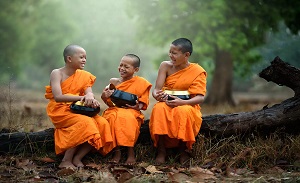About Buddhist Monks
 The serene, orange-robed Buddhist monk has become an iconic figure in the West. Recent news stories about violent Buddhist monks in Burma reveal that they aren't always serene, however. And they don't all wear orange robes. Some of them aren't even celibate vegetarians who live in monasteries.
The serene, orange-robed Buddhist monk has become an iconic figure in the West. Recent news stories about violent Buddhist monks in Burma reveal that they aren't always serene, however. And they don't all wear orange robes. Some of them aren't even celibate vegetarians who live in monasteries.
A Buddhist monk is a bhiksu (Sanskrit) or bhikkhu (Pali), The Pali word is more frequently used, I believe. It is pronounced (roughly) bi-KOO. Bhikkhu means something like "mendicant."
Although the historical Buddha did have lay disciples, early Buddhism was primarily monastic. From the foundations of Buddhism the monastic sangha has been the primary container that maintained the integrity of the dharma and passed it on to new generations. For centuries the monastics were the teachers, scholars, and clergy.
Unlike most Christian monks, in Buddhism the fully ordained bhikkhu or bhikkhuni (nun) is also the equivalent of a priest. See "Buddhist vs. Christian Monasticism" for more comparisons of Christian and Buddhist monks.
The Establishment of the Lineage Tradition
The original order of bhikkhus and bhikkhunis was established by the historical Buddha. According to Buddhist tradition, at first, there was no formal ordination ceremony. But as the number of disciples grew, the Buddha adopted more stringent procedures, in particular when people were ordained by senior disciples in the Buddha's absence.
One of the most important stipulations attributed to the Buddha was that fully ordained bhikkhus must be present at the ordination of bhikkhus and fully ordained bhikkhus and bhikkhunis present at the ordination of bhikkhunis. When carried out, this would create an unbroken lineage of ordinations going back to the Buddha.
This stipulation created a tradition of a lineage that is respected -- or not -- to this day. Not all orders of clergy in Buddhism claim to have remained in the lineage tradition, but others do.
Much of Theravada Buddhism is thought to have maintained an unbroken lineage for bhikkhus but not for bhikkhunis, so in much of southeast Asia women are denied full ordination because there are no more fully ordained bhikkhunis to attend the ordinations. There is a similar issue in Tibetan Buddhism because it appears the bhikkhuni lineages were never transmitted to Tibet.
The Vinaya
Rules for the monastic orders attributed to the Buddha are preserved in the Vinaya or Vinaya-pitaka, one of the three "baskets" of the Tipitaka. As is often the case, however, there is more than one version of the Vinaya.
Theravada Buddhists follow the Pali Vinaya. Some Mahayana schools follow other versions that were preserved in other early sects of Buddhism. And some schools, for one reason or another, no longer follow any complete version of the Vinaya.
For example, the Vinaya (all versions, I believe) provides that monks and nuns be entirely celibate. But in the 19th century, the Emperor of Japan revoked celibacy in his empire and ordered monks to marry. Today it's often expected of a Japanese monk to marry and beget little monks.
Two Tiers of Ordination
After the death of the Buddha, the monastic sangha adopted two separate ordination ceremonies. The first is a kind of novice ordination that is often referred to as "home leaving" or "going forth." Usually, a child has to be at least 8 years old to become a novice,
When the novice reaches the age of 20 or so, he may request full ordination. Usually, the lineage requirements explained above apply only to full ordinations, not novice ordinations. Most monastic orders of Buddhism have kept some form of two-tier ordination system.
Neither ordination is necessarily a life-long commitment. If someone wishes to return to lay life he may do so. For example, the 6th Dalai Lama chose to renounce his ordination and live as a layman, yet he was still the Dalai Lama.
In Theravadin countries of southeast Asia, there is an old tradition of teenage boys taking novice ordination and living as monks for a short time, sometimes only for a few days, and then returning to lay life.
Monastic Life and Work
The original monastic orders begged for their meals and spent most of their time in meditation and study. Theravada Buddhism continues this tradition. The bhikkhus depend on alms to live. In many Theravada countries, the novice nuns who have no hope of full ordination are expected to be housekeepers for monks.
When Buddhism reached China, the monastics found themselves in a culture that didn't approve of begging. For that reason, Mahayana monasteries became as self-sufficient as possible, and the chores -- cooking, cleaning, gardening -- became part of monastic training, and not just for the novices.
In modern times, it is not unheard of for ordained bhikkhus and bhikkhunis to live outside of a monastery and hold a job. In Japan, and in some Tibetan orders, they might even be living with a spouse and children.
About the Orange Robes
Buddhist monastic robes come in many colors, from blazing orange, maroon, and yellow, to black. They also come in many styles. The orange off-the-shoulder number of the iconic monk generally is seen only in southeast Asia.
By Barbara O'Brien
https://www.learnreligions.com/

